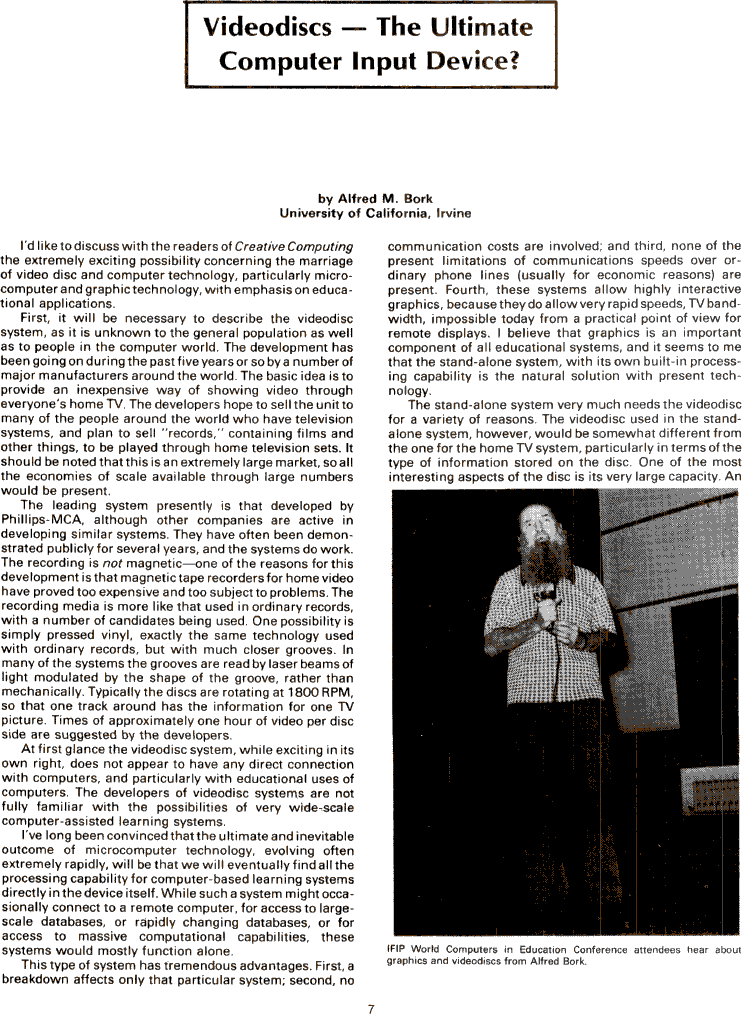by Alfred M. Bork

Videodiscs - The Ultimate Computer Input Device?
by Alfred M. Bork
University of California, Irvine
I'd like to discuss with the readers of Creative Computing the extremely
exciting possibility concerning the marriage of video disc and computer
technology, particularly microcomputer and graphic technology, with emphasis on
educational applications.
First, it will be necessary to describe the videodisc system, as it is unknown
to the general population as well as to people in the computer world. The
development has been going on on during the past five years or so by a number of
major manufacturers around the world. The basic idea is to provide an
inexpensive way of showing video through everyone's home TV. The developers hope
to sell the unit to many of the people around the world who have television
systems, and plan to sell "records," containing films and other things, to be
played through home television sets. It should be noted that this is an
extremely large market, so all
the economies of scale available through large numbers would be present.
The leading system presently is that developed by Phillips-MCA, although other
companies are active in
developing similar systems. They have often been demonstrated publicly for
several years, and the systems do work. The recording is not magnetic-one of the
reasons for this development is that magnetic tape recorders for home video have
proved too expensive and too subject to problems. The recording media is more
like that used in ordinary records, with a number of candidates being used. One
possibility is simply pressed vinyl, exactly the same technology used with
ordinary records, but with much closer grooves. In many of the systems the
grooves are read by laser beams of light modulated by the shape of the groove,
rather than mechanically. Typically the discs are rotating at 1800 RPM, so that
one track around has the information for one TV picture. Times of approximately
one hour of video per disc side are suggested by the developers.
At first glance the videodisc system, while exciting in its own right, does not
appear to have any direct connection with computers, and particularly with
educational uses of computers. The developers of videodisc systems are not fully
familiar with the possibilities of very wide-scale computer-assisted earning
systems.
I've long been convinced that the ultimate and inevitable outcome of
microcomputer technology, evolving often
extremely rapidly, will be that we will eventually find all the processing
capability for computer-based learning systems directly in the device itself.
While such a system might occasionally connect to a remote computer, for access
to largescale databases, or rapidly changing databases, or for access to massive
computational capabilities, these systems would mostly function alone.
This type of system has tremendous advantages. First, a breakdown affects only
that particular system; second, no communication costs are involved; and third,
none of the present limitations of communications speeds over ordinary phone
lines (usually for economic reasons) are present. Fourth, these systems allow
highly interactive graphics, because they do allow very rapid speeds, TV
bandwidth, impossible today from a practical point of view for remote displays.
I believe that graphics is an important component of all educational systems,
and it seems to me that the stand-alone system, with its own built-in processing
capability is the natural solution with present technology.
The stand-alone system very much needs the videodisc for a variety of reasons.
The videodisc used in the standalone system, however, would be somewhat
different from the one for the home TV system, particularly in terms of the type
of information stored on the disc. One of the most interesting aspects of the
disc is its very large capacity. An
[image] IFIP World Computers in Education Conference attendees hear about
graphics and videodiscs from Alfred Bork.
7

